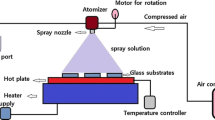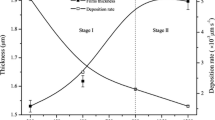Abstract
Two-dimensional (2D) disordered copper 1,3,5-tricarboxylate film on copper foil was first reported in this paper. In the x-ray powder diffraction pattern of the as-prepared film, there were only two diffraction peaks exist in d value of 6.60 and 3.32 Å, which were correspond to the (400) and (800) diffractions of bulk HKUST-1, respectively. And the d value of 6.60 Å in bulk HKUST-1 is very close to the thickness of one-layered Cu2+ plus one-layered C9H3O63− (6.59 Å). The structure of as-prepared film was proved to be 2D disordered copper 1,3,5-tricarboxylate film. The periodical stacking of Cu2+ and C9H3O63−is perpendicular to the substrate. There is no periodic structure within the layer. Scanning electron microscopy, transmission electron microscope (TEM), high-resolution transmission electron microscope, infrared, Raman, and x-ray photoelectron spectrometer supported this result. This kind of disorder probably also existed in the reported HKUST-1 film that shows strong (400) diffraction in x-ray diffraction (XRD) pattern. This result probably explains why (400) diffraction in XRD pattern of reported synthesized HKUST-1 film is anomalously strong. This strategy is simple. No seed, no pretreated solvothermal mother liquors, and no specific functionalization are required.





Similar content being viewed by others
REFERENCES
S. Kitagawa, R. Kitaura, and S. Noro: Functional porous coordination polymers. Angew. Chem. Int. Ed. 43(18), 2334 (2004).
M. O’Keeffe, M. Eddaoudi, H.L. Li, T. Reineke, and O.M. Yaghi: Frameworks for extended solids: Geometrical design principles. J. Solid State Chem. 152(1), 3 (2000).
G. Férey, C. Mellot-Draznieks, C. Serre, F. Millange, J. Dutour, S. Surblé, and I. Margiolaki: A chromium terephthalate-based solid with unusually large pore volumes and surface area. Science 309, 2040 (2005).
Y.B. Zhang, H.L. Zhou, R.B. Lin, C. Zhang, J.B. Lin, J.P. Zhang, and X.M. Chen: Geometry analysis and systematic synthesis of highly porous isoreticular frameworks with a unique topology. Nat. Commun. 3, 642 (2012).
L. Alaerts, C.E.A. Kirschhock, M. Maes, M.A. van der Veen, V. Finsy, A. Depla, J.A. Martens, G.V. Baron, P.A. Jacobs, J.F.M. Denayer, and D.E. De Vos: Selective adsorption and separation of xylene isomers and ethylbenzene with the microporous vanadium(IV) terephthalate MIL-47. Angew. Chem. Int. Ed. 46, 4293 (2007).
J.Y. Lee, D.H. Olson, L. Pan, T.J. Emge, and J. Li: Microporous metal-organic frameworks with high gas sorption and separation capacity. Adv. Funct. Mater. 17, 1255 (2007).
R-Q. Zou, H. Sakurai, S. Han, R-Q. Zhong, and Q. Xu: Probing the Lewis acid sites and CO catalytic oxidation activity of the porous metal-organic polymer [Cu(5-methylisophthalate)]. J. Am. Chem. Soc. 129, 8402 (2007).
T.K. Maji, R. Matsuda, and S. Kitagawa: A flexible interpenetrating coordination framework with a bimodal porous functionality. Nat. Mater. 6, 142 (2007).
S.S.Y. Chui, S.M.F. Lo, J.P.H. Charmant, A.G. Orpen, and I.D. Williams: A chemically functionalizable nanoporous material [Cu3(TMA)2(H2O)3]n. Science 283, 1148 (1999).
H.L. Guo, G.S. Zhu, I.J. Hewitt, and S.L. Qiu: “Twin copper source” growth of metal-organic framework membrane: Cu3(BTC)2 with high permeability and selectivity for recycling H2. J. Am. Chem. Soc. 131, 1646 (2009).
Q.M. Wang, D.M. Shen, M. Bülow, M.L. Lau, S.G. Deng, F.R. Fitch, N.O. Lemcoff, and J. Semanscin: Metallo-organic molecular sieve for gas separation and purification. Microporous Mesoporous Mater. 55, 217 (2002).
A.I. Skoulidas: Molecular dynamics simulations of gas diffusion in metal-organic frameworks: Argon in CuBTC. J. Am. Chem. Soc. 126, 1356 (2004).
Q.Y. Yang, C.Y. Xue, C.L. Zhong, and J.F. Chen: Molecular simulation of separation of CO2 from flue gases in Cu-BTC metal-organic framework. AIChE J. 53, 2832 (2007).
S. Keskin, J.C. Liu, J.K. Johnson, and D.S. Sholl: Atomically detailed models of gas mixture diffusion through CuBTC membranes. Microporous Mesoporous Mater. 125, 101 (2009).
K. Szelagowska-Kunstman, P. Cyganik, M. Goryl, D. Zacher, Z. Puterova, R.A. Fischer, and M. Szymonski: Surface structure of metal-organic framework grown on self-assembled monolayers revealed by high-resolution atomic force microscopy. J. Am. Chem. Soc. 130, 14446 (2008).
M.D. Allendorf, R.J.T. Houk, L. Andruszkiewicz, A.A. Talin, J. Pikarsky, A. Choudhury, K.A. Gall, and P.J. Hesketh: Stress-induced chemical detection using flexible metal-organic frameworks. J. Am. Chem. Soc. 130, 14404 (2008).
E. Biemmi, C. Scherb, and T. Bein: Oriented growth of the metal organic framework Cu3(BTC)2(H2O)3·xH2O tunable with functionalized self-assembled monolayers. J. Am. Chem. Soc. 129, 8054 (2007).
A. Schoedel, C. Scherb, and T. Bein: Oriented nanoscale films of metal-organic frameworks by room-temperature gel-layer synthesis. Angew. Chem. Int. Ed. 49, 7225 (2010).
E. Biemmi, A. Darga, N. Stock, and T. Bein: Direct growth of Cu3(BTC)2(H2O)3·xH2O thin films on modified QCM-gold electrodes water sorption isotherms. Microporous Mesoporous Mater. 114, 380 (2008).
V.V. Guerrero, Y. Yoo, M.C. McCarthy, and H-K. Jeong: HKUST-1 membranes on porous supports using secondary growth. J. Mater. Chem. 20, 3938 (2010).
R. Ameloot, E. Gobechiya, H. Uji-i, J.A. Martens, J. Hofkens, L. Alaerts, B.F. Sels, and D.E. De Vos: Direct patterning of oriented metal-organic framework crystals via control over crystallization kinetics in clear precursor solutions. Adv. Mater. 22, 2685 (2010).
R. Ameloot, L. Pandey, M.V. Auweraer, L. Alaerts, B.F. Sels, and D.E. De Vos: Patterned film growth of metal–organic frameworks based on galvanic displacement. Chem. Commun. 46, 3735 (2010).
R. Ameloot, L. Stappers, J. Fransaer, L. Alaerts, B.F. Sels, and D.E. De Vos: Patterned growth of metal-organic framework coatings by electrochemical synthesis. Chem. Mater. 21, 2580 (2009).
J. Gascon, S. Aguado, and F. Kapteijn: Manufacture of dense coatings of Cu3(BTC)2 (HKUST-1) on α-alumina. Microporous Mesoporous Mater. 113, 132 (2008).
J-L. Zhuang, D. Ceglarek, S. Pethuraj, and A. Terfort: Rapid room-temperature synthesis of metal-organic framework HKUST-1 crystals in bulk and as oriented and patterned thin films. Adv. Funct. Mater. 21, 1442 (2011).
O. Shekhah, J. Liu, R.A. Fischerb, and C. Wöll: MOF thin films: Existing and future applications. Chem. Soc. Rev. 40, 1081 (2011).
Z-Q. Li, L-G. Qiu, T. Xu, Y. Wu, W. Wang, Z-Y. Wu, and X. Jiang: Ultrasonic synthesis of the microporous metal-organic framework Cu3(BTC)2 at ambient temperature and pressure: An efficient and environmentally friendly method. Mater. Lett. 63, 78 (2009).
O. Shekhah, H. Wang, S. Kowarik, F. Schreiber, M. Paulus, M. Tolan, C. Sternemann, F. Evers, D. Zacher, R.A. Fischer, and C. Wöll: Step-by-step route for the synthesis of metal-organic frameworks. J. Am. Chem. Soc. 129, 15118 (2007).
D. Zacher, O. Shekhah, C. Wöll, and R.A. Fischer: Thin films of metal-organic frameworks. Chem. Soc. Rev. 38, 1418 (2009).
D. Zacher, J. Liu, K. Huber, and R.A. Fischer: Nanocrystals of [Cu3(btc)2](HKUST-1): A combined time-resolved light scattering and scanning electron microscopy study. Chem. Commun. 45, 1031 (2009).
J.P. Nan, X.L. Dong, W.J. Wang, W.Q. Jin, and N.P. Xu: Step-by-step seeding procedure for preparing HKUST-1 membrane on porous α-alumina support. Langmuir 27, 4309 (2011).
W.X. Zhang, X.G. Wen, S.H. Yang, Y. Berta, and Z.L. Wang: Single-crystalline scroll-type nanotube arrays of copper hydroxide synthesized at room temperature. Adv. Mater. 15, 822 (2003).
X.G. Wen, S.H. Wang, Y.T. Xie, X-Y. Li, and S.H. Yang: Low-temperature synthesis of single crystalline Ag2S nanowires on silver substrates. J. Phys. Chem. B 109, 10100 (2005).
JCPDF Card No. 50–0663.
C. Prestipino, L. Regli, J.G. Vitillo, F. Bonino, A. Damin, C. Lamberti, A. Zecchina, P.L. Solari, K.O. Kongshaug, and S. Bordiga: Local structure of framework Cu(II) in HKUST-1 metal-organic framework: Spectroscopic characterization upon activation and interaction with adsorbates. Chem. Mater. 18, 1337 (2006).
J. Ghijsen, L.H. Tjeng, J.V. Elp, H. Eskes, J. Westerink, and G.A. Sawatzky: Electronic structure of Cu2O and CuO. Phys. Rev. B 38, 11322 (1988).
S.K. Chawla, N. Sankarraman, and J.H. Payer: Diagnostic spectra for XPS analysis of Cu-O-S-H compounds. J. Electron. Spectrosc. Relat. Phenom. 61, 1 (1992).
W.X. Zhang and S.H. Yang: In situ fabrication of inorganic nanowire arrays grown from and aligned on metal substrates. Acc. Chem. Res. 42(10), 1617 (2009).
ACKNOWLEDGMENTS
This work was supported by “the Fundamental Research Funds for the Central Universities” (Grant No. 11lgpy10).
Author information
Authors and Affiliations
Corresponding author
Supplementary Material
Supplementary Material
Supplementary materials can be viewed in this issue of the Journal of Materials Research by visiting {rs|http://journals.cambridge.org/jmr|url|}.
Rights and permissions
About this article
Cite this article
Chen, C., Qi, Y. & Qiao, Z. Fabrication of two-dimensional disordered copper 1,3,5-tricarboxylate film by vapor–solid method. Journal of Materials Research 27, 2911–2915 (2012). https://doi.org/10.1557/jmr.2012.336
Received:
Accepted:
Published:
Issue Date:
DOI: https://doi.org/10.1557/jmr.2012.336




